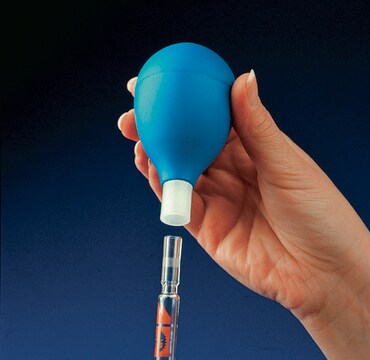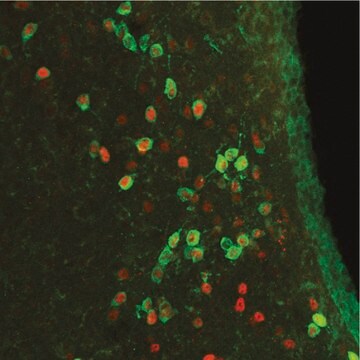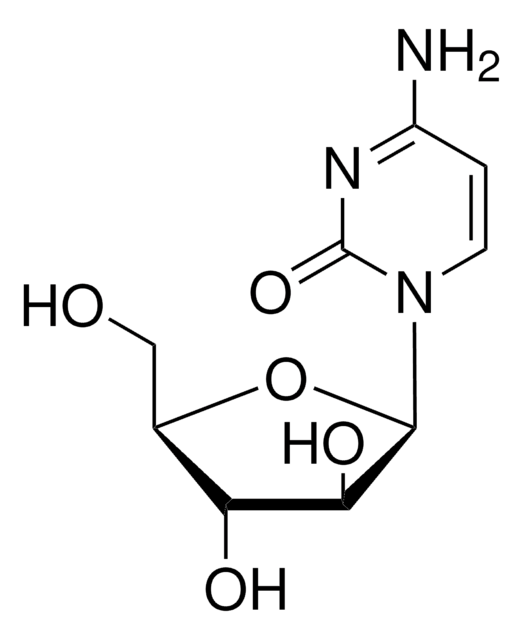추천 제품
생물학적 소스
mouse
Quality Level
항체 형태
purified antibody
항체 생산 유형
primary antibodies
클론
R24, monoclonal
종 반응성
human, mouse, rat
기술
affinity binding assay: suitable
flow cytometry: suitable
immunohistochemistry (formalin-fixed, paraffin-embedded sections): suitable
immunoprecipitation (IP): suitable
western blot: suitable
동형
IgG3κ
배송 상태
ambient
타겟 번역 후 변형
unmodified
유전자 정보
human ... ST8SIA1(6489)
일반 설명
Gangliosides are sialic acid-containing oligoglycosylceramides. They are classified based on the number of sialic acid residues per molecule. GM gangliosides contain one sialic acid residue, GD gangliosides contain two, GT contain three, and GQ contain four sialic acid residues. Sialyltransferase-catalyzed 2-3 sialylation of the galactose of the trisaccharide Gal 1-4Glc 1-1 Cer produces GM3, which can be further sialylated to produce GD3 with two sialic acid on the galactose. GD3 is found in melanocytes and other cells that originate in the neuroectoderm. It is expressed almost exclusively among gangliosides in the early stage of the brain development of mice and rats. It is also detected in the T cell malignant leukocytes, such as acute lymphoblastic leukemia cells, adult T cell leukemia cells, and in activated normal human T lymphocytes. GD3 is found in almost all melanomas and is considered as an important biomarker for malignant melanoma. GD3 positive cells show markedly increased cell growth and invasive characteristics. Suppression of GD3 expression with antisense GD3 synthase cDNA is shown to reduce tumor cell phenotypes such as growth, migration, metastasis, and angiogenesis in F11 cells. Intra-cytoplasmic domain of neogenin is reported to act as a driver to promote various cancer phenotypes. Ref.: Hamamura, K et al. (2005). Proc. Natl. Acad. Sci. USA. 102 (31), 11041 11046; Dippold, WG et al. (1985). Cancer Res. 45(8): 3699-3705; Kaneko, K et al (2016). J. Biol. Chem. (In press).
특이성
Clone R24 (a.k.a. R-24) immunostained neurites of cultured DRG neurons from wild-type, but not GD3 synthase-knockout, mice (Ribeiro-Resende, V.T., et al. (2014). PLoS One. 9(10):e108919).
Target glycolipid is not species-specific.
면역원
SK-MEL-28 human melanoma cells (Dippold, W.G., et al. (1980). Proc. Natl. Acad. Sci. U.S.A. 77(10):6114-6118).
애플리케이션
Affects Function: A representative lot induced cellular Lyn kinase activity and tyrosine phosphorylation of cellular proteins of primary rat cerebellar cultures in a time-dependent manner (Kasahara, K., et al. (1997). J. Biol. Chem. 272(47):29947-29953).
Affinity Binding Assay: A representative lot reacted with heat stable glycolipid on the surface of all SK-MEL melanoma and two of the five astrocytoma cells tested, whereas epithelial cell types, fibroblasts, and cells of hematopoietic origin were found to lack the surface antigen recognized by clone R24 (Dippold, W.G., et al. (1980). Proc. Natl. Acad. Sci. U.S.A. 77(10):6114-6118).
Flow Cytometry Analysis: A representative lot immunostained the surface of cultured primary rat cerebellar cells (Kasahara, K., et al. (1997). J. Biol. Chem. 272(47):29947-29953).
Immunocytochemistry Analysis: A representative lot immunostained NGF-induced nurite outgrowths of cultured DRG neurons from wild-type, but not GD3 synthase-knockout, mice (Ribeiro-Resende, V.T., et al. (2014). PLoS One. 9(10):e108919).
Immunohistochemistry Analysis: A representative lot detected GD3 immunoreactivity in unfixed frozen tissue samples of primary melanoma and metastatic malignant melanoma (Dippold, W.G., et al. (1985). Cancer Res. 45(8):3699-3705).
Immunoprecipitation Analysis: A representative lot co-immunoprecipitated Lyn from rat brain membrane extract. Clone R24 co-immunoprecipitated caveolin and the exogenously expressed Lyn, but not Src, from CHO cells expressing exogenous GD3 synthase (Kasahara, K., et al. (1997). J. Biol. Chem. 272(47):29947-29953).
Affinity Binding Assay: A representative lot reacted with heat stable glycolipid on the surface of all SK-MEL melanoma and two of the five astrocytoma cells tested, whereas epithelial cell types, fibroblasts, and cells of hematopoietic origin were found to lack the surface antigen recognized by clone R24 (Dippold, W.G., et al. (1980). Proc. Natl. Acad. Sci. U.S.A. 77(10):6114-6118).
Flow Cytometry Analysis: A representative lot immunostained the surface of cultured primary rat cerebellar cells (Kasahara, K., et al. (1997). J. Biol. Chem. 272(47):29947-29953).
Immunocytochemistry Analysis: A representative lot immunostained NGF-induced nurite outgrowths of cultured DRG neurons from wild-type, but not GD3 synthase-knockout, mice (Ribeiro-Resende, V.T., et al. (2014). PLoS One. 9(10):e108919).
Immunohistochemistry Analysis: A representative lot detected GD3 immunoreactivity in unfixed frozen tissue samples of primary melanoma and metastatic malignant melanoma (Dippold, W.G., et al. (1985). Cancer Res. 45(8):3699-3705).
Immunoprecipitation Analysis: A representative lot co-immunoprecipitated Lyn from rat brain membrane extract. Clone R24 co-immunoprecipitated caveolin and the exogenously expressed Lyn, but not Src, from CHO cells expressing exogenous GD3 synthase (Kasahara, K., et al. (1997). J. Biol. Chem. 272(47):29947-29953).
Detect ganglioside GD3 using this mouse monoclonal Anti-Diasialoganglioside GD3, clone R24 Antibody, Cat. No. MABC1112, validated for use in Flow Cytometry and Immunocytochemistry, Western Blotting, Affects Function, Immunoprecipitation, Immunohistochemistry (Paraffin), Immunohistochemistry, Affinit
Research Category
Apoptosis & Cancer
Apoptosis & Cancer
품질
Evaluated by Flow Cytometry Analysis in SK-MEL-28 human skin melanoma cells.
Flow Cytometry Analysis: 0.2 µL of this antibody detected GD3 immunoreactivity on the surface of one million SK-MEL-28 human skin melanoma cells.
Flow Cytometry Analysis: 0.2 µL of this antibody detected GD3 immunoreactivity on the surface of one million SK-MEL-28 human skin melanoma cells.
물리적 형태
Format: Purified
Protein G purified
Purified mouse monoclonal antibody IgG3 in PBS without azide.
저장 및 안정성
Stable for 1 year at -20°C from date of receipt.
Handling Recommendations: Upon receipt and prior to removing the cap, centrifuge the vial and gently mix the solution. Aliquot into microcentrifuge tubes and store at -20°C. Avoid repeated freeze/thaw cycles, which may damage IgG and affect product performance.
Handling Recommendations: Upon receipt and prior to removing the cap, centrifuge the vial and gently mix the solution. Aliquot into microcentrifuge tubes and store at -20°C. Avoid repeated freeze/thaw cycles, which may damage IgG and affect product performance.
기타 정보
Concentration: Please refer to lot specific datasheet.
면책조항
Unless otherwise stated in our catalog or other company documentation accompanying the product(s), our products are intended for research use only and are not to be used for any other purpose, which includes but is not limited to, unauthorized commercial uses, in vitro diagnostic uses, ex vivo or in vivo therapeutic uses or any type of consumption or application to humans or animals.
적합한 제품을 찾을 수 없으신가요?
당사의 제품 선택기 도구.을(를) 시도해 보세요.
Storage Class Code
12 - Non Combustible Liquids
WGK
WGK 2
Flash Point (°F)
Not applicable
Flash Point (°C)
Not applicable
시험 성적서(COA)
제품의 로트/배치 번호를 입력하여 시험 성적서(COA)을 검색하십시오. 로트 및 배치 번호는 제품 라벨에 있는 ‘로트’ 또는 ‘배치’라는 용어 뒤에서 찾을 수 있습니다.
자사의 과학자팀은 생명 과학, 재료 과학, 화학 합성, 크로마토그래피, 분석 및 기타 많은 영역을 포함한 모든 과학 분야에 경험이 있습니다..
고객지원팀으로 연락바랍니다.






